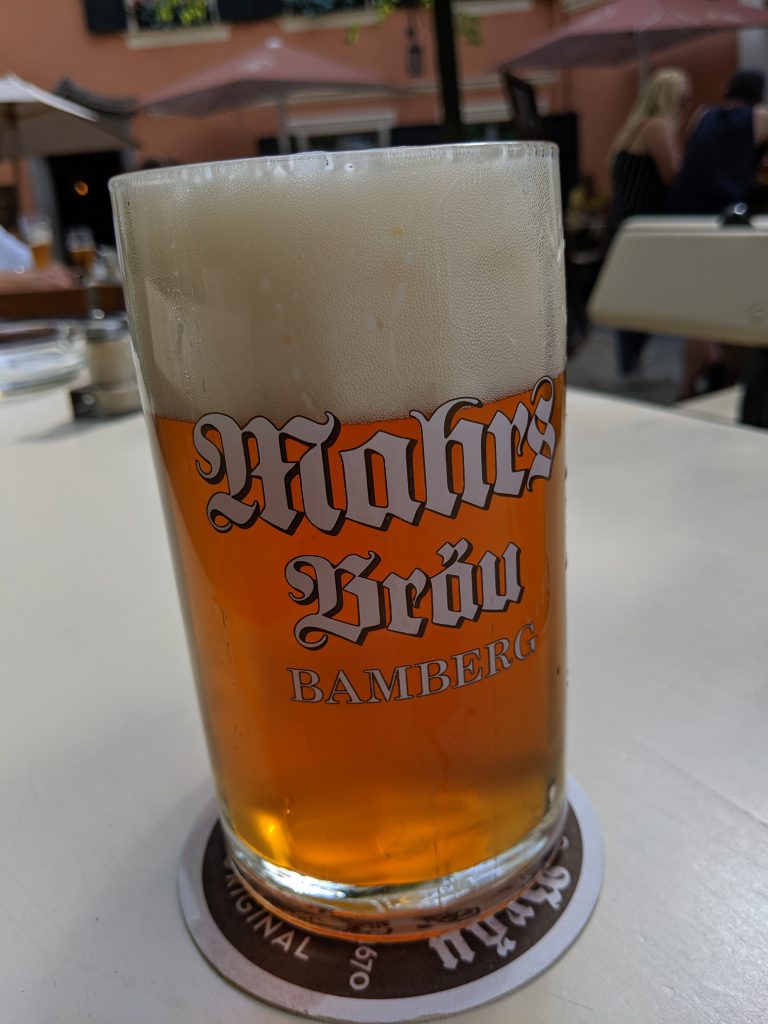As I’ve announced a month ago, my homebrewing project for 2020 is to develop a clone recipe for Mahrs aU. I brewed the first iteration on December 27, and here’s a quick report on how that went:
My grist was fairly simple, 2.4 kg Pilsner malt and 2.4 kg Munich I malt, both from Weyermann. I doughed in with 20 litres of water which I had treated with 6 ml of lactic acid (something something counteract local water’s hardness, I calculated this ages ago and stuck to it since, I’m terrible with water chemistry). I then conducted my preferred double decoction mash where I start with a very large thick decoction, rest it at around 70°C when heating up, then boil it and mix it back, and then pull a thin decoction, boil it, and mix it back again. The temperature steps the main mash was undergoing in this case were 39°C (dough-in temperature), 62°C and 72°C. I then moved the mash to the lauter tun, recirculated to get clear wort and then started lautering, measuring 17.6 Brix on the first runnings. I continuously sparge, and after 30 minutes, I had enough wort collected to bring it to a boil. Pre-boil gravity as determined by refractometer was 11 Brix.
After 90 minute boil, with hop additions (2019 harvest Perle, 7.2% alpha acid) at 90 minutes (32g) and 10 minutes (10g) before the end of the boil, I moved the wort the a fermenter and chilled it down to 10°C before adding two rehydrated sachets of W-34/70 yeast. Fermentation took off about 36 hours after pitching the yeast.
Things didn’t go quite as planned, as the wort’s OG turned out to be 13.3°P. My grist calculation was based on previous batches in which I employed the same mashing regime, but this time, for whatever reason, efficiency was quite a bit better than what I wanted to achieve. I’m not going to complain about it, as it’s only 0.6°P (roughly 0.002 in gravity points) higher than where I wanted to get to.
Fermentation was quite a bit slower than usual. I’m not sure why, but I may have rehydrated the dry yeast improperly, therefore slightly underpitching. Even after four weeks, fermentation did not seem quite finished. I would have waited, but two days ago, another problem came up: the seal on the fermenter’s tap was leaking. Not a whole lot, but in the tray underneath, a few hundred ml of beer had built up. Since this was just the first iteration, and things weren’t 100% right from the beginning, I decided for an emergency plan: instead of lagering properly, I just cold-crashed the beer, hoping not more would leak between Friday and today, and then bottled the beer today. With 4.4°P, I’m not 100% sure the beer had completely finished fermenting (though there wasn’t really much of a noticeable residual sweetness), but I bottled it anyway and just let it naturally carbonate over the next few weeks. To be frank, I’m not particularly happy with that, but given that things weren’t right from the beginning, it’s still an acceptable shortcut for a first iteration.
A quick taste test directly from the fermenter revealed that the beer indeed tasted remarkably close to the original Mahrs aU. While the beer was pretty clean-tasting, the hop bitterness still seemed a bit rough. My concern is that whenever this has aged a bit and smoothed out, the bitterness might not be quite high enough. Bear in mind that I based the hop additions and overall bitterness just on some very flimsy circumstantial evidence. Since then, I’ve received multiple pointers to other sources talking about the Mahrs aU parameters, such as this very helpful comment by DB who mentioned that Michael Jackson had written about aU in 1999, when it was still bittered with Northern Brewer and Hallertauer Tradition to 36 IBU, and this reply on Twitter pointing out that Ron Pattinson’s book Decoction! (seriously, you should buy it) contains OG, ABV, real extract, apparent attenuation, colour and bitterness from the year 2000 for “Mahr’s Bräu ungespundet – hefetrüb” (aka Mahrs aU), setting the bitterness at a whopping 42.5 EBU.
I’m still waiting for the bottled beer to condition and slightly mature before I’ll start a proper taste test the results of which will then be the basis for my next step. Based on the brew day itself, I will probably slightly reduce the amount of malt the next time so that I can get closer to 12.7°P in OG than the 13.3°P of the first iteration. Also depending on how the bitterness shines through, I may slightly increase the bittering hops.
I also chucked out that particular fermenter and ordered myself a 30 litre Speidel fermenter instead.

